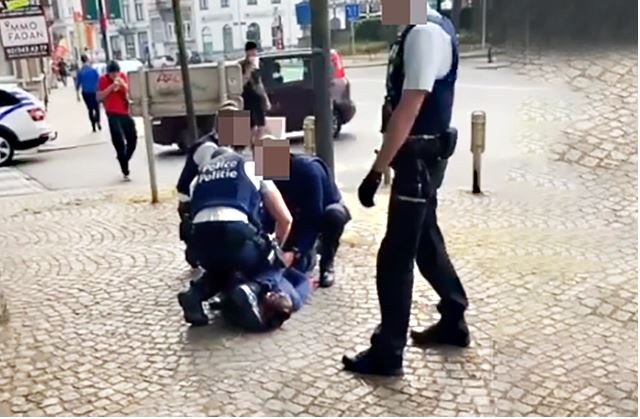The technique used to arrest a young man while he was lying on the ground near the Wolvendael Park in the Brussels commune of Uccle on Thursday was entirely legal, according to the police zone responsible.
On Thursday around 5:00 PM, the police in Uccle arrested a man for disturbing the public order close to the Wolvendael Park.
Images of a bystander show how a police officer puts his knee on the arrested man's back to handcuff him. An entirely legal technique that is not at all comparable to the one that led to the death of George Floyd in the United States, according to the Marlow police zone, which includes Uccle.
The police intervened at the request of local residents, who had complained repeatedly about a group of young people disturbing the peace and quiet in the park and the surrounding area, according to La Capitale.
The video of the arrest was put online and shows how several officers arrest one man, with one officer putting his knee on the man's back.
The man who filmed can be heard telling the officers that there is no need for so many of them, as the man they are arresting is on his own. "Come on, a knee on his head, is that a joke or something? This what we are protesting for, and you put a knee (...)," said the French-speaking man who recorded the video.
"The man who was arrested was aggressive and did not want to be handcuffed," Philip Vanhees, spokesperson of the police zone, told Bruzz. "That is why he was handcuffed lying down. His limbs are immobilised on the ground, so that he cannot kick or hit. We do not do this systematically, only when it's strictly necessary," he added.
Related News
- 'Shock' at Brussels cop seen kneeling on teenager's neck after BLM protest
- Probe launched after Brussels cop seen kneeling on teen's neck
Three officers held the man down during the arrest, and the footage shows one policeman putting his knee on the arrested man's shoulder blade.
That is exactly by the book, according to Vanhees. "The technique used in these circumstances is also the one taught in police schools to keep the head of an arrested person on the ground so they cannot bite," he said, stressing that the technique differs fundamentally from the one used in the U.S. which resulted in George Floyd's death.
"Kneeling on the spine, as happens in the U.S., can cause nerve damage. Arrestees can become paralysed as a result. That is why this is not permitted in Belgium," said Vanhees. "What is allowed, however, is a lower leg on the shoulder blade of the arrested person, only until they are handcuffed. This whole arrest, for example, only lasted just over a minute," he added.
The basis for the check was legitimate, and the technique was used well, said Vanhees. "You can also clearly see that the officers allowed the maker of the video to record," he said, adding that the police zone advised the officers to file a complaint against the filming man.
"He posted the footage of the clearly recognisable policemen on a website where there are calls to kill police officers. That puts things in perspective," Vanhees said.
The Marlow zone has recently acquired bodycams, and is in the process of training their staff to use them.
In the future, the zone wants to be able to show what happened before and after such an arrest as people say that these arrests are shameful, "but they don't see the run-up to it," Vanhees said.
Last weekend, the technique used by officers from the Brussels-Capital-Ixelles police zone to arrest a teen after the Black Lives Matter protest on Sunday was also the focus of questioning, as bystanders said they saw an officer kneeling on the teen's neck.
However, the officer's knee was not on the teen's neck, but on his shoulder, according to the police spokesperson, who stressed that the arrest was carried out by an officer of a specialised unit who was particularly experienced in the methods of control and arrest.
Maïthé Chini
The Brussels Times

